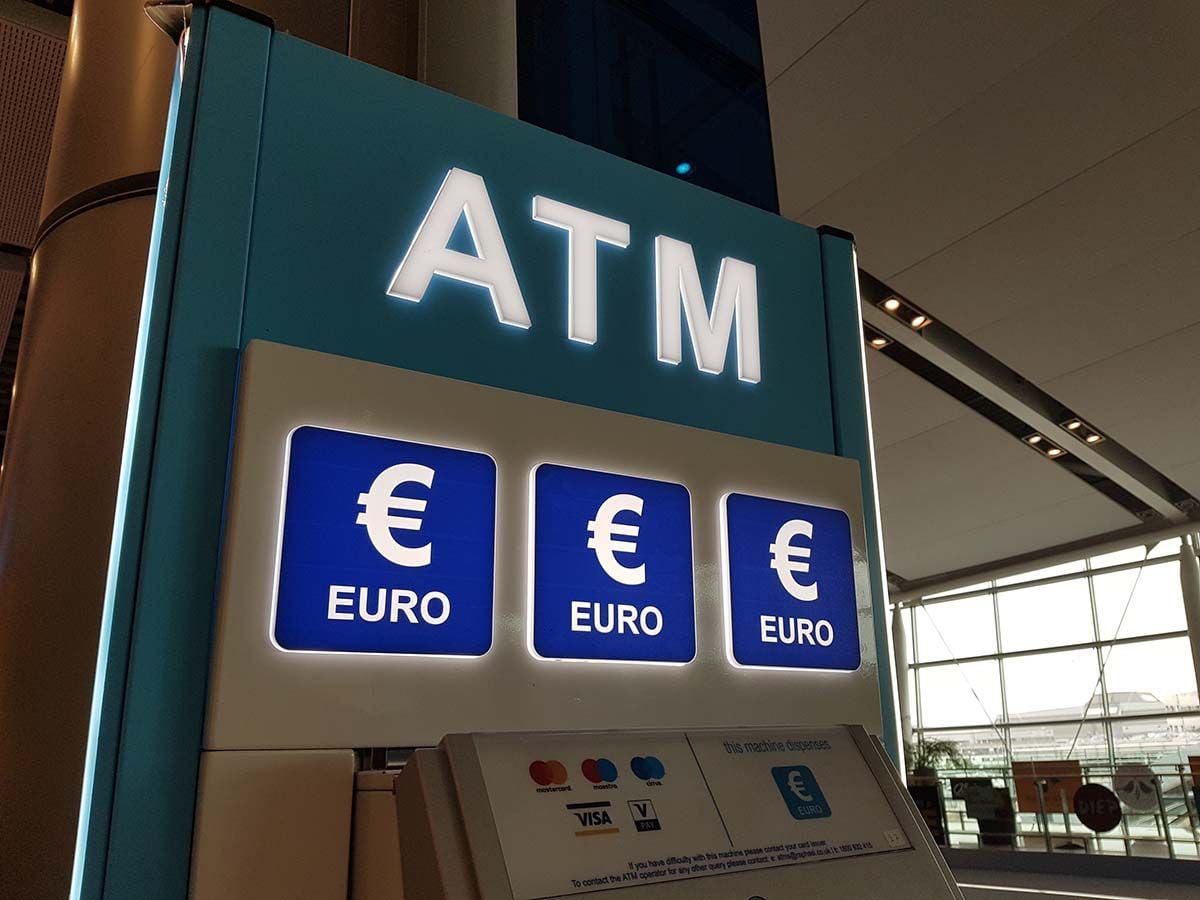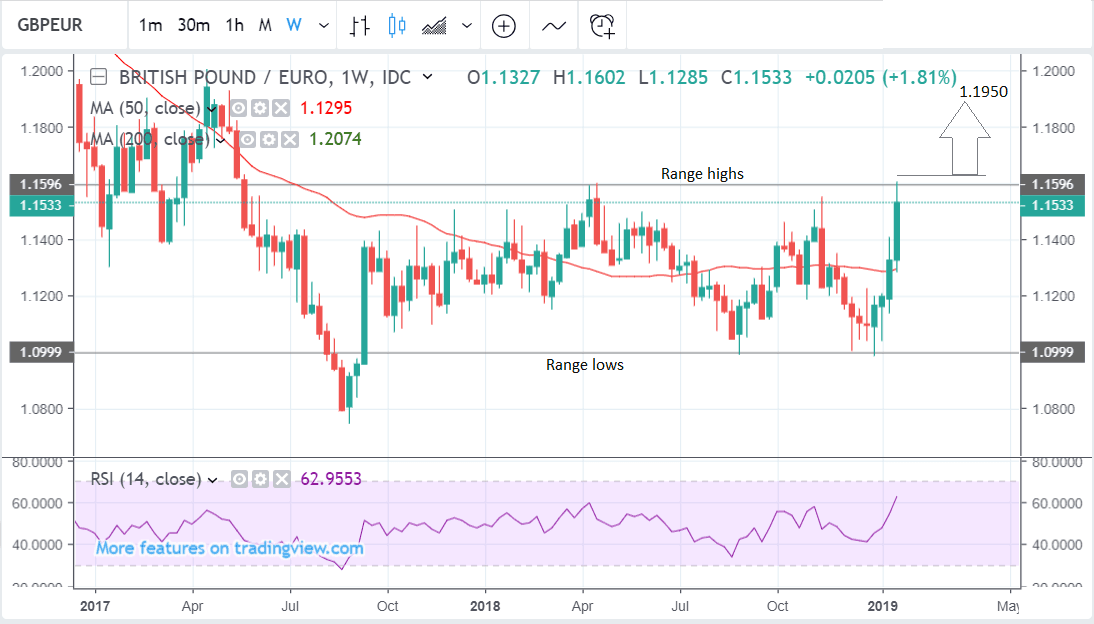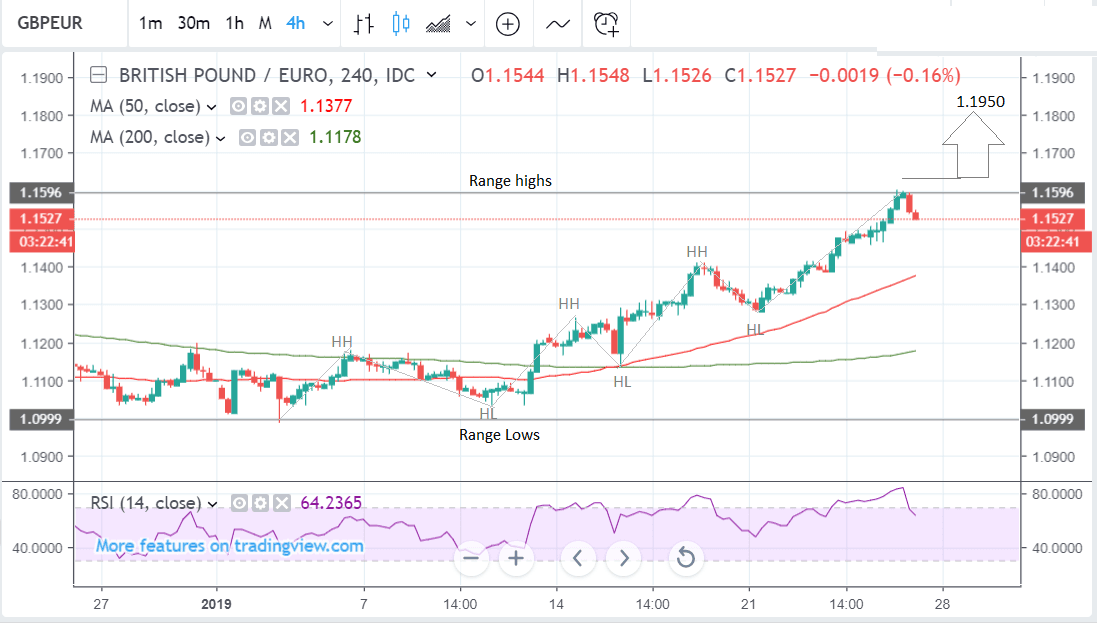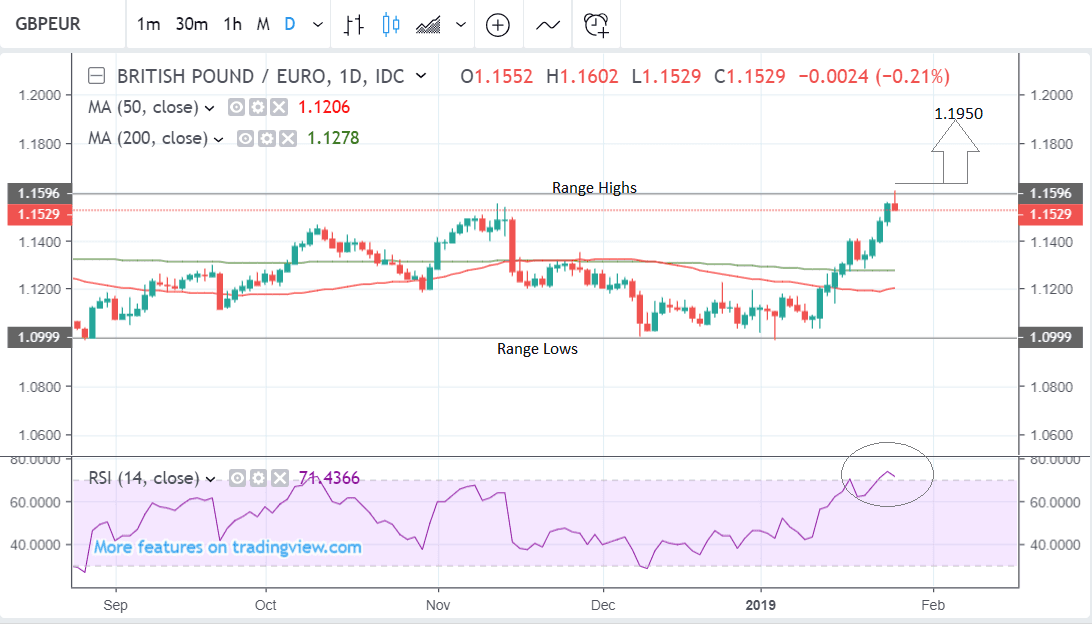Pound-to-Euro Exchange Rate 5-Day Forecast: Momentum Remains Positive, Tuesday's Parliamentary Votes Dominate the Calendar

Image © Pound Sterling Live
- GBP/EUR is trading at the top of its 2018 range
- Break above the 1.1600 highs would be bullish
- Initial target at 1.1690; main target at 1.1950
Short-term technical indicators for the Pound remain positive and suggest further gains against the Euro are possible in the coming week. The key events to watch on the calendar include Tuesday's votes on Brexit in the UK parliament and Thursday's Eurozone GDP data release.
The Pound-to-Euro exchange rate starts the new week at 1.1573 1.1527 on Friday after rising 2.14% during the previous week. Gains have come mostly as a result of the strengthening of the Pound on a steadily diminishing probability of a 'no deal' Brexit, whilst the pair also rose at the end of the week as a result of the European Central Bank (ECB) issuing a much more cautious assessment of the Eurozone economy.
Concerning the exchange rate's technical outlook, the pair is marginally favoured to extend higher, given the old adage that ‘the trend is your friend’ which suggests the uptrend is more likely to continue than reverse.
The trend is unclear on the weekly and daily charts (which give a longer-term overview) as the exchange rate remains locked inside a range between 1.1200 and 1.1600, but scoping into the shorter time frame charts reveals a clearer trend direction.
Any doubt as to the trajectory of the short-term trend should be dispelled by careful observation of the 4-hr chart which shows the pair climbing in an uninterrupted sequence of more than two higher highs (HH) and higher lows (HL), which is the hallmark of a new uptrend.
GBP/EUR has just touched the 1.1600 range highs and undergone a shallow pull-back, however, we see scope for further gains if it can pierce the range ceiling and breakout. Such a move would be confirmed by a break above - first the 1.1602 Friday highs - and then 1.1625, 1.1650 for more assured confirmation levels.
The RSI momentum indicator in the lower pane on both the daily and weekly charts is rising strongly in parallel with the exchange rate, which further supports the uptrend. The RSI is actually overbought on the daily and 4hr charts suggesting the possibility of some short-term weakness, but there is nothing to suggests this will be anything more than corrective in nature.
The pair is above all major moving averages on the daily and weekly charts adding further evidence to support a continuation higher for the uptrend.
As far as upside targets go, and initial target sits at 1.1690 where a technical resistance level called the R2 monthly pivot sits. This is likely to be reached in the week ahead.
This is followed by round-number targets at 1.1800, 1.1900 and then the main upside target at 1.1950, based on the extrapolation of the height of the range higher. This may take 1-3 months to reach.
Time to move your money? Get 3-5% more currency than your bank would offer by using the services of foreign exchange specialists at RationalFX. A specialist broker can deliver you an exchange rate closer to the real market rate, thereby saving you substantial quantities of currency. Find out more here.
* Advertisement
The British Pound this Week
On Tuesday parliament votes on the government's 'plan B' on Brexit, which could give us a better steer on where the UK is headed and further cement expectations that a 'no deal' Brexit is becoming increasingly unlikely.
It is the growing expectation for this worst-case scenario to be avoided that has provided the fundamental fuel to the Pound's impressive start to 2019.
Prime Minister Theresa May is widely expected to say she will go back to Brussels to ask for further concessions required to make the Brexit deal more palatable to those in her party that voted against it earlier this month.
However, focus is likely to be on the amendments that will be tabled alongside the 'plan B' on Tuesday. The Cooper-Boles amendment is perhaps the
most significant as it gives Parliament the opportunity to force the government into requesting an extension to Brexit if parliament fails to approved a deal by February 26.
We believe the EU would consider such a request with Austrian Chancellor Sebastian Kurz saying last week any extension would likely only last three months.
While any delay only serves to extend the Brexit-induced uncertainty hanging over the UK economy, it does signal to the market that a worst-case scenario for Sterling - a 'no deal' Brexit - becomes increasingly unlikely.
On the data front, Friday February 01 sees the release of manufacturing PMI data, with markets expecting a reading of 53.5, down on the previous month's 54.2.
"While we expect only a moderate fall in January’s manufacturing PMI, recent weakness in the eurozone PMI means a larger drop cannot be ruled out," says Ruth Gregory, Senior UK Economist with Capital Economics.
We expect any impact on the Pound from data to be relatively short-lived owing to the all-encompassing importance of Brexit politics.
The Euro this Week
Wednesday will give us several confidence indexes for January. The confidence trend has so far remained negative in the Eurozone, but the gain of 0.4 points in the preliminary version of consumer confidence in January is a good sign.
However, the PMI indexes have continued to fall; the Euroland composite index dropped from 51.1 to 50.7, its lowest level since summer 2013.
Eurozone GDP data is due out on Thursday, January 31, and this month's release will likely attract more attention than usual owing to the recent slowdown in Eurozone economic growth.
Consensus estimates see growth coming in 0.2% quarter-on-quarter for the fourth quarter of 2018, The year-on-year rate is forecast to read at 1.2% in December.
A number below expectation would likely prompt Euro weakness, as it would suggest to markets the European Central Bank (ECB) will become increasingly cautious on raising interest rates.
The further back the date of a first interest rate rise is pushed, the softer the outlook for Euro exchange rates become.
The Euro fell last week after ECB President Mario Draghi told journalists the ECB now believe that risks to the outlook for the Eurozone economy have moved to the downside.
"The near-term growth momentum is likely to be weaker than previously anticipated," said Draghi, adding significant stimulus is still needed to sustain inflation. This marks a more cautious tone from the ECB which appears to have dropped its previous optimism on the trajectory of the Eurozone's economy in 2019, and makes it unlikely we will see an interest rate rise come under the stewardship of Draghi who will hand over the reins to a new President in 2020.
Time to move your money? Get 3-5% more currency than your bank would offer by using the services of foreign exchange specialists at RationalFX. A specialist broker can deliver you an exchange rate closer to the real market rate, thereby saving you substantial quantities of currency. Find out more here.
* Advertisement







